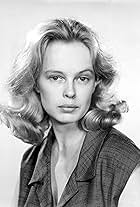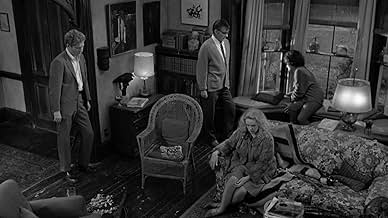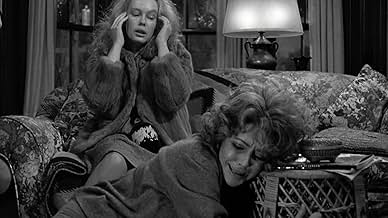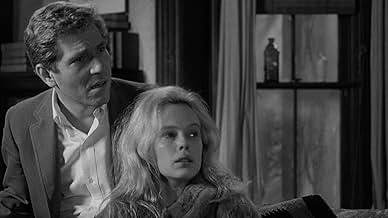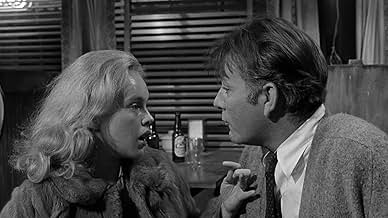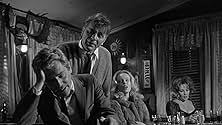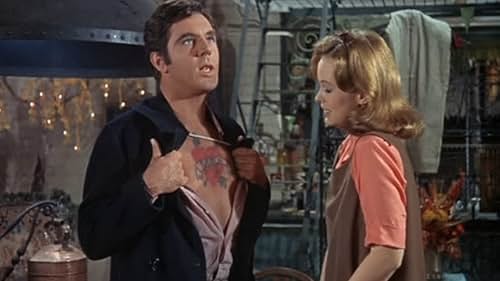Sandy Dennis(1937-1992)
- Actress
It would not be easy for anyone to out-do one of American theater's finest thespians, but somehow actress Sandy Dennis managed to even out-quirk the legendaryGeraldine Pagewhen it came to affecting nervous tics and offbeat mannerisms on stage and in film. She and Page had few peers when it came to the neurotic-dispensing department. The two Actor's Studio disciples developed fascinating characterizations that seemed to manifest themselves outwardly to such physical extremes and, like a bad car accident, their overt styling was capable of both drawing in, and repelling audiences. There was no gray area. Either way, both had a searing emotional range and were undeniably transfi xing figures who held up Oscar trophies to prove there was a "Method" to their respective madness. Sandy's signature quirks--her stuttering, fluttering, throat gulps, eye twitches, nervous giggles, hysterical flailing--are all a part of what made her so distinctive and unforgettable. Her untimely death of cancer at age 54 robbed the entertainment industry of a remarkable talent.
The Nebraska-born-and-bred actress was born Sandra Dale Dennis in Hastings, on April 27, 1937, the daughter of postal clerk Jack Dennis and his secretary wife Yvonne (née Hudson), who divorced in 1966 after a 38-year marriage. Living in both Kenesaw (1942) and Lincoln (1946) while growing up, she and brother Frank went to Lincoln High School with TV hostDick Cavett.Her passion for acting grew and grew while still at home. A college student at both Nebraska Wesleyan University and the University of Nebraska, she eventually found her career direction after appearing with the Lincoln Community Theater Group.
The toothy actress left Nebraska and towards the Big Apple at age 19 just to try her luck. An intense student of acting guruUta Hagen,Sandy made her New York stage debut in a Tempo Theatre production of "The Lady from the Sea" in 1956 and that same year won her first TV role as that of Alice Holden in the daytime seriesThe Guiding Light (1952).A year later she made it to Broadway as an understudy (and eventual replacement) for the roles of Flirt and Reenie in theWilliam Ingedrama "The Dark at the Top of the Stairs," directed byElia Kazanat the Music Box Theatre. She toured with that production and also found regional work in the plays "Bus Stop" and "Motel" while continuing to shine as a budding New York fixture in "Burning Bright," "Face of a Hero" and "Port Royal".
Along with fellow newcomersGary LockwoodandPhyllis Diller,Sandy made her movie debut in playwright Inge'sSplendor in the Grass (1961),a movie quite welcoming of Sandy's neurotic tendencies. In the minor but instrumental role of Kay, she is an unwitting instigator of friend Deanie's (played by an ambitiously unbalancedNatalie Wood) mental collapse. Despite this worthy little turn, Sandy would not make another film for five years.
Instead, the actress set her sights strongly on the stage and for this she was handsomely rewarded, most notably in comedy. After appearing in a two-month run of theGraham Greenedrama "The Complaisant Lover" at the Ethel Barrymore Theatre in 1961, stardom would be hers the very next year with her outstanding social worker role in the lighter-weight "A Thousand Clowns". Winning the Theatre World as well as the coveted Tony Award for her performance, she continue her run of prizes with a second consecutive Tony for her sexy turn in the comedy "Any Wednesday" (1964). Having made only one picture at this juncture, Sandy was not in a good position to transfer her award-winning characters to film and when they did, they went toBarbara HarrisandJane Fonda,respectively.
TV was also a viable medium for Sandy and she appeared sporadically on such programs asThe Fugitive (1963),Naked City (1958)andArrest and Trial (1963).In 1965, she appeared in London as Irina in a heralded Actor's Studio production of Chekhov's "The Three Sisters" with fellow devoteesGeraldine Page,Kim Stanley,Shelley Winters,Luther AdlerandKevin McCarthy.The play was subsequently videotaped and directed byPaul Bogart,and is valuable today for the studied "Method" performances of its cast. It, however, received mixed reviews upon its release.
Returning to film in 1966, Sandy seemed to embellish every physical and emotional peculiarity she could muster for the role of the mousy wife Honey in the four-character powerhouse playWho's Afraid of Virginia Woolf? (1966)byEdward Albee.It is a mouth-dropping, emotionally shattering performance, and both she and a more even-keeledGeorge Segalas the drop over guests of the skewering cutthroat couple George and Martha (Elizabeth TaylorandRichard Burton) more than held their own. While the distaff cast won Oscars for this (Taylor for "Best Actress" and Dennis for "Best Supporting Actress" ), this ferocious landmark film blew open the "Production Code" doors once and for all and a wave of counterculture filming tackling formerly taboo subjects came to be.
Firmly established now with her Oscar win, Sandy found highly affecting lead showcases for herself. She starred as a young, naive English teacher challenged by a New York "Blackboard Jungle" -like school system inUp the Down Staircase (1967).She also stirred up some controversy along withAnne Heywoodplaying brittle lesbian lovers whose relationship is threatened by a sexy male visitor (Keir Dullea) in another ground-breaking filmThe Fox (1967).Sandy remained intriguingly off-kilter in the odd-couple romantic storySweet November (1968)oppositeAnthony Newley,the bizarreRobert AltmanthrillerThat Cold Day in the Park (1969),and the gloomy British melodramaA Touch of Love (1969)[aka Thank You All Very Much].
Off-camera, Sandy lived for over a decade with jazz musician and saxophonistGerry Mulligan,which began in 1965 following his devoted relationship with actressJudy Hollidaywho had died of cancer earlier in the year. They eventually parted ways in 1976. Rumors that they had married at some point were eventually negated by Sandy herself. Sandy also went on to have a May-December relationship with the equally quirky actorEric Robertsfrom 1980 to 1985. She had no children.
At the peak of her film popularity, Sandy began the 1970s in more mainstream fashion. She andJack Lemmonwere another odd-couple hit inNeil Simon'sThe Out of Towners (1970)as married George and Gwen Kellerman visiting an unmerciful Big Apple. Sandy is at her whiny, plain-Jane best ( "Oh, my God...I think we're being kidnapped!" ) as disaster upon disaster befalls the miserable twosome. Both she and Lemmon were nominated for Golden Globes. Following this, however, Sandy again refocused on the stage with an avalanche of fine performances in "How the Other Half Loves," "And Miss Reardon Drinks a Little," "A Streetcar Named Desire" (as Blanche), "Born Yesterday" (as Billie Dawn), "Absurd Person Singular," "Cat on a Hot Tin Roof" (as Maggie the Cat), "Same Time, Next Year," "The Little Foxes," "Eccentricities of a Nightingale," "The Supporting Cast" and even the title role in "Peter Pan".
A few TV and movie roles came Sandy's way in unspectacular fashion but it wasn't until the next decade that she again stole some thunder. After a moving support turn as a cast-off wife in the finely-tuned ensemble dramaThe Four Seasons (1981),Sandy proved terrific as a James Dean extremist in another ensemble filmCome Back to the 5 & Dime Jimmy Dean, Jimmy Dean (1982),which she played first to fine acclaim on Broadway. Reunited with directorRobert Altmanas well as her stage compatriotsCher,Karen Black,Kathy Bates,Sudie BondandMarta Heflin,the film version was equally praised. Her last films includedAnother Woman (1988),976-EVIL (1988)andParents (1989).
Seen less and less in later years, she gave in to her eccentric tendencies as time went on. A notorious cat lover (at one point there was a count of 33 residing in her Westport, Connecticut home), close friends included actressesBrenda VaccaroandJessica Walter.Her father Jack died in 1990 and around that same time Sandy was diagnosed with ovarian cancer. Undergoing chemotherapy at the time she filmed the part of a beaten-down mother inSean Penn'sThe Indian Runner (1991),the role proved to be her last.
Sandy died in Westport on March 2, 1992. Her ashes were placed at the Lincoln Memorial Park in Lincoln, Nebraska. A foundation in her home state was set up to "memorialize the accomplishments of Sandy Dennis, to perpetuate her commitment to education and the performing arts, to promote cultural activities, and to encourage theatrical education, performance, and professionals". A book, "Sandy Dennis: A Personal Memoir," was published posthumously in 1997.
The Nebraska-born-and-bred actress was born Sandra Dale Dennis in Hastings, on April 27, 1937, the daughter of postal clerk Jack Dennis and his secretary wife Yvonne (née Hudson), who divorced in 1966 after a 38-year marriage. Living in both Kenesaw (1942) and Lincoln (1946) while growing up, she and brother Frank went to Lincoln High School with TV hostDick Cavett.Her passion for acting grew and grew while still at home. A college student at both Nebraska Wesleyan University and the University of Nebraska, she eventually found her career direction after appearing with the Lincoln Community Theater Group.
The toothy actress left Nebraska and towards the Big Apple at age 19 just to try her luck. An intense student of acting guruUta Hagen,Sandy made her New York stage debut in a Tempo Theatre production of "The Lady from the Sea" in 1956 and that same year won her first TV role as that of Alice Holden in the daytime seriesThe Guiding Light (1952).A year later she made it to Broadway as an understudy (and eventual replacement) for the roles of Flirt and Reenie in theWilliam Ingedrama "The Dark at the Top of the Stairs," directed byElia Kazanat the Music Box Theatre. She toured with that production and also found regional work in the plays "Bus Stop" and "Motel" while continuing to shine as a budding New York fixture in "Burning Bright," "Face of a Hero" and "Port Royal".
Along with fellow newcomersGary LockwoodandPhyllis Diller,Sandy made her movie debut in playwright Inge'sSplendor in the Grass (1961),a movie quite welcoming of Sandy's neurotic tendencies. In the minor but instrumental role of Kay, she is an unwitting instigator of friend Deanie's (played by an ambitiously unbalancedNatalie Wood) mental collapse. Despite this worthy little turn, Sandy would not make another film for five years.
Instead, the actress set her sights strongly on the stage and for this she was handsomely rewarded, most notably in comedy. After appearing in a two-month run of theGraham Greenedrama "The Complaisant Lover" at the Ethel Barrymore Theatre in 1961, stardom would be hers the very next year with her outstanding social worker role in the lighter-weight "A Thousand Clowns". Winning the Theatre World as well as the coveted Tony Award for her performance, she continue her run of prizes with a second consecutive Tony for her sexy turn in the comedy "Any Wednesday" (1964). Having made only one picture at this juncture, Sandy was not in a good position to transfer her award-winning characters to film and when they did, they went toBarbara HarrisandJane Fonda,respectively.
TV was also a viable medium for Sandy and she appeared sporadically on such programs asThe Fugitive (1963),Naked City (1958)andArrest and Trial (1963).In 1965, she appeared in London as Irina in a heralded Actor's Studio production of Chekhov's "The Three Sisters" with fellow devoteesGeraldine Page,Kim Stanley,Shelley Winters,Luther AdlerandKevin McCarthy.The play was subsequently videotaped and directed byPaul Bogart,and is valuable today for the studied "Method" performances of its cast. It, however, received mixed reviews upon its release.
Returning to film in 1966, Sandy seemed to embellish every physical and emotional peculiarity she could muster for the role of the mousy wife Honey in the four-character powerhouse playWho's Afraid of Virginia Woolf? (1966)byEdward Albee.It is a mouth-dropping, emotionally shattering performance, and both she and a more even-keeledGeorge Segalas the drop over guests of the skewering cutthroat couple George and Martha (Elizabeth TaylorandRichard Burton) more than held their own. While the distaff cast won Oscars for this (Taylor for "Best Actress" and Dennis for "Best Supporting Actress" ), this ferocious landmark film blew open the "Production Code" doors once and for all and a wave of counterculture filming tackling formerly taboo subjects came to be.
Firmly established now with her Oscar win, Sandy found highly affecting lead showcases for herself. She starred as a young, naive English teacher challenged by a New York "Blackboard Jungle" -like school system inUp the Down Staircase (1967).She also stirred up some controversy along withAnne Heywoodplaying brittle lesbian lovers whose relationship is threatened by a sexy male visitor (Keir Dullea) in another ground-breaking filmThe Fox (1967).Sandy remained intriguingly off-kilter in the odd-couple romantic storySweet November (1968)oppositeAnthony Newley,the bizarreRobert AltmanthrillerThat Cold Day in the Park (1969),and the gloomy British melodramaA Touch of Love (1969)[aka Thank You All Very Much].
Off-camera, Sandy lived for over a decade with jazz musician and saxophonistGerry Mulligan,which began in 1965 following his devoted relationship with actressJudy Hollidaywho had died of cancer earlier in the year. They eventually parted ways in 1976. Rumors that they had married at some point were eventually negated by Sandy herself. Sandy also went on to have a May-December relationship with the equally quirky actorEric Robertsfrom 1980 to 1985. She had no children.
At the peak of her film popularity, Sandy began the 1970s in more mainstream fashion. She andJack Lemmonwere another odd-couple hit inNeil Simon'sThe Out of Towners (1970)as married George and Gwen Kellerman visiting an unmerciful Big Apple. Sandy is at her whiny, plain-Jane best ( "Oh, my God...I think we're being kidnapped!" ) as disaster upon disaster befalls the miserable twosome. Both she and Lemmon were nominated for Golden Globes. Following this, however, Sandy again refocused on the stage with an avalanche of fine performances in "How the Other Half Loves," "And Miss Reardon Drinks a Little," "A Streetcar Named Desire" (as Blanche), "Born Yesterday" (as Billie Dawn), "Absurd Person Singular," "Cat on a Hot Tin Roof" (as Maggie the Cat), "Same Time, Next Year," "The Little Foxes," "Eccentricities of a Nightingale," "The Supporting Cast" and even the title role in "Peter Pan".
A few TV and movie roles came Sandy's way in unspectacular fashion but it wasn't until the next decade that she again stole some thunder. After a moving support turn as a cast-off wife in the finely-tuned ensemble dramaThe Four Seasons (1981),Sandy proved terrific as a James Dean extremist in another ensemble filmCome Back to the 5 & Dime Jimmy Dean, Jimmy Dean (1982),which she played first to fine acclaim on Broadway. Reunited with directorRobert Altmanas well as her stage compatriotsCher,Karen Black,Kathy Bates,Sudie BondandMarta Heflin,the film version was equally praised. Her last films includedAnother Woman (1988),976-EVIL (1988)andParents (1989).
Seen less and less in later years, she gave in to her eccentric tendencies as time went on. A notorious cat lover (at one point there was a count of 33 residing in her Westport, Connecticut home), close friends included actressesBrenda VaccaroandJessica Walter.Her father Jack died in 1990 and around that same time Sandy was diagnosed with ovarian cancer. Undergoing chemotherapy at the time she filmed the part of a beaten-down mother inSean Penn'sThe Indian Runner (1991),the role proved to be her last.
Sandy died in Westport on March 2, 1992. Her ashes were placed at the Lincoln Memorial Park in Lincoln, Nebraska. A foundation in her home state was set up to "memorialize the accomplishments of Sandy Dennis, to perpetuate her commitment to education and the performing arts, to promote cultural activities, and to encourage theatrical education, performance, and professionals". A book, "Sandy Dennis: A Personal Memoir," was published posthumously in 1997.
